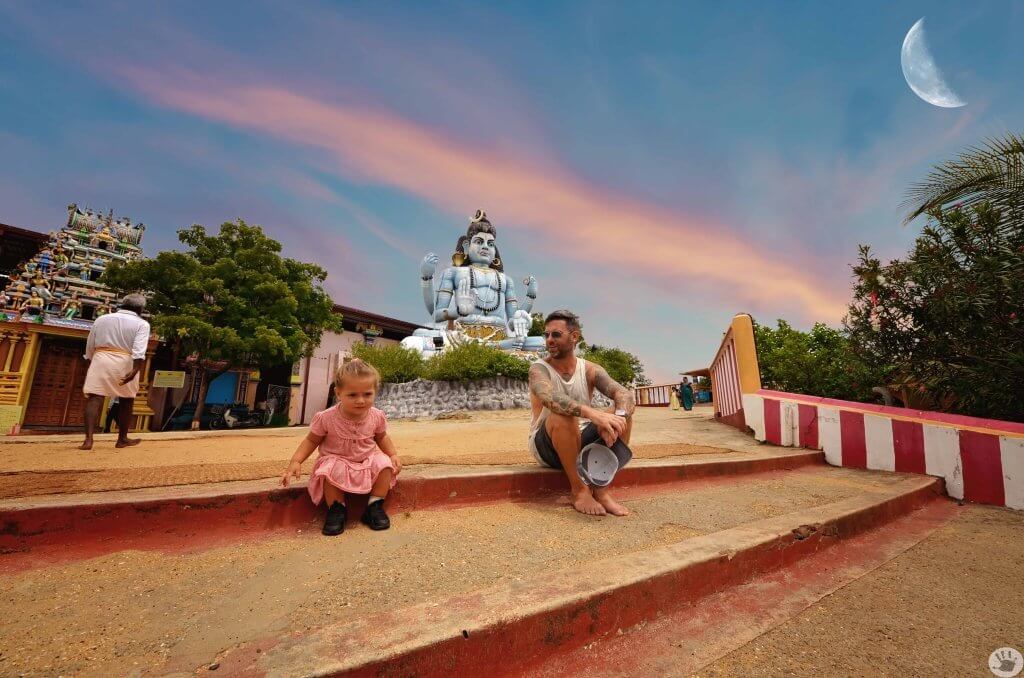Who is Shiva and Why is Shiva Blue?
Exploring the Thirukoneswaram Kovil Shaktipeeth

Before I tell you who is Shiva, why Shiva is blue, and much more about Hinduism, I want to share where I visited the most beautiful temple dedicated to Shiva (in my opinion).
We tak about
ToggleIn the heart of Trincomalee, Sri Lanka, stands the majestic Thirukoneswaram Kovil Shaktipeeth, a place steeped in spirituality and millennia of history. This was the highlight of our trip and an experience that can inspire your own journey to Sri Lanka.
If you want to read more about our itinerary in Sri Lanka with the kids, check out my dedicated article.
Meeting Indian Shiva Devotees: Why is Shiva Blue?
Immersed in the daily life of Thirukoneswaram Kovil Shaktipeeth, we ventured among unique visitors: Indian tourists on pilgrimage. This authentic touch made our trip even more special, opening doors to meaningful conversations and sharing curiosities about who is Shiva and Hinduism.
Hinduism and Shiva: An Ancient Philosophy of Life and Spirituality
Before delving into the magnificent temple of Trincomalee, who is Shiva, and why Shiva is blue, let’s briefly cover the basics of Hinduism.
Hinduism, one of the oldest religions in the world, is much more than a set of beliefs; it’s a philosophy of life infused with spirituality. Characterized by its diversity and flexibility, Hinduism has no single founder or holy book but embraces a vast collection of ancient texts called the Vedas, Upanishads, and epics like the Mahabharata and Ramayana. At its heart, Hinduism teaches the pursuit of truth, compassion, and the interconnectedness of all creation.
Fundamental Concepts: Karma, Dharma, and Moksha
At the core of Hinduism are three key concepts that guide the lives of its followers. Karma, the principle of action and consequences, emphasizes the importance of acting with wisdom and compassion. Dharma represents moral duty and cosmic order, promoting an ethical and just lifestyle. Moksha, the ultimate goal, signifies liberation from the cycle of birth, death, and rebirth, leading the soul to a state of eternal bliss and union with the divine.
Polytheism and Multiform Deities: A Mosaic of Gods
Hinduism is known for its vast pantheon of deities, each with unique characteristics and profound symbolism.
- Brahma, the creator
- Vishnu, the preserver
- Shiva, the destroyer and recreator
These three deities form the primary trinity, but there are countless other gods, each revered for specific qualities. Personal devotion can vary widely, allowing practitioners to choose the deity that resonates most with their spirituality.
The Main Deities of Hinduism: Why is Shiva Blue?
Vishnu and Brahma: Cosmic Balance
While Vishnu preserves the universe, Brahma creates it. Together with Shiva, they form a fundamental cosmic balance in Hinduism.
Shiva, the Lord of Destruction and Reconstruction: But Why is Shiva Blue?
Shiva, with his trident and snake around his neck, symbolizes the destructive force that precedes creation and completes the Hindu trinity. His importance in Hinduism is profound, representing the eternal cycle of life, death, and rebirth.
Enlightening Conversations: Shiva and His Iconic Representation
At the Shiva temple in Trincomalee, we were fortunate to meet numerous Indian tourists on pilgrimage. Engaging with the devotees, we discovered fascinating details about who is Shiva and his representation. These cultural exchanges enriched our trip, turning it into not just a tourist experience but also a spiritual one.
Who is Shiva?
Who is Shiva? This question guided our journey to Thirukoneswaram Kovil Shaktipeeth. Shiva is the god of change, destruction, and transformation.
Good or Evil?
Shiva remains one of the most complex and revered deities in Hinduism, defying conventional labels of “good” or “evil.” His nature is intrinsically dual, representing a dynamic balance between opposing forces. Shiva is known as the “Lord of Destruction and Reconstruction,” embodying the cyclical nature of life, death, and rebirth in the universe.
Traditionally, the attribute of “good” or “evil” is often influenced by cultural and individual perspectives. Shiva, with his image of a meditative ascetic, symbolizes the rejection of worldly attachments and illusions, representing a path towards spiritual liberation. This manifestation of Shiva as the destroyer of illusions can be interpreted as a “good” force, aiming to free individuals from the chains of ignorance.
On the other hand, Shiva is also known for his cosmic dance, called “Tandava,” which symbolizes the destruction of the old order to make way for the new. This form of Shiva may appear as a destructive force, but in the context of Hinduism, it is considered necessary for renewal and creation. Therefore, destruction is not inherently “bad” but an integral part of the eternal cycle of existence.
Moreover, Shiva is often revered as “Bholenath,” the Innocent Lord, an aspect that shows his compassion and kindness towards devotees. Mythological stories tell of instances where Shiva, despite his powerful nature, manifests with humility and welcomes anyone who approaches him with devotion. This compassion represents a “good” side of Shiva, resonating with those seeking protection and spiritual guidance.
In summary, labeling Shiva as exclusively “good” or “bad” is reductive, as his essence transcends superficial dualities. Shiva is a symbol of harmony between opposites, inviting worshippers to contemplate the complexity of life and embrace the totality of existence. His duality reflects the very nature of the universe, where contrasting forces coexist to maintain cosmic balance.
Discovering his complexity opened our eyes to a rich and diverse spirituality.
Traveling in the Land of Hinduism with Kids
For families seeking a unique experience, the Thirukoneswaram Kovil Shaktipeeth offers not only an opportunity to explore spirituality but also to connect with authentic culture.
Engaging Kids with Depictions of Shiva
Kids will be fascinated by the vivid representations of Shiva. Involving them in these experiences will enrich your trip in a memorable way.
But Why is Shiva Blue?
According to Hinduism, during the creation of the world, nectar and poison were spread. Shiva drank the poison to save the Earth. The poison stayed stuck in his throat, which is why his neck, and in many representations his entire figure, turned blue.
Who is Shiva? A Journey of Understanding
Our trip to Thirukoneswaram Kovil Shaktipeeth was much more than a simple tourist visit. Immersed in the spirituality of Shiva and surrounded by the genuineness of Indian pilgrims, we discovered a world of meaning and connection. Shiva, with his duality of destruction and creation, taught us that every end is also a new beginning, and we finally know why Shiva is blue.
Digitally Yours
☀️ Sara ☀️



